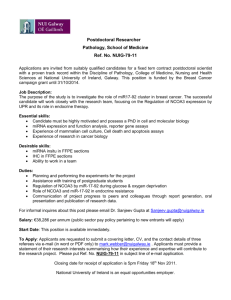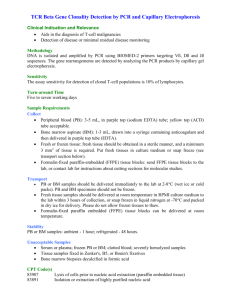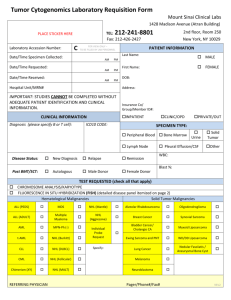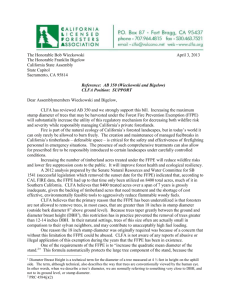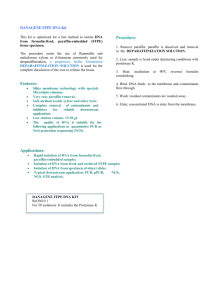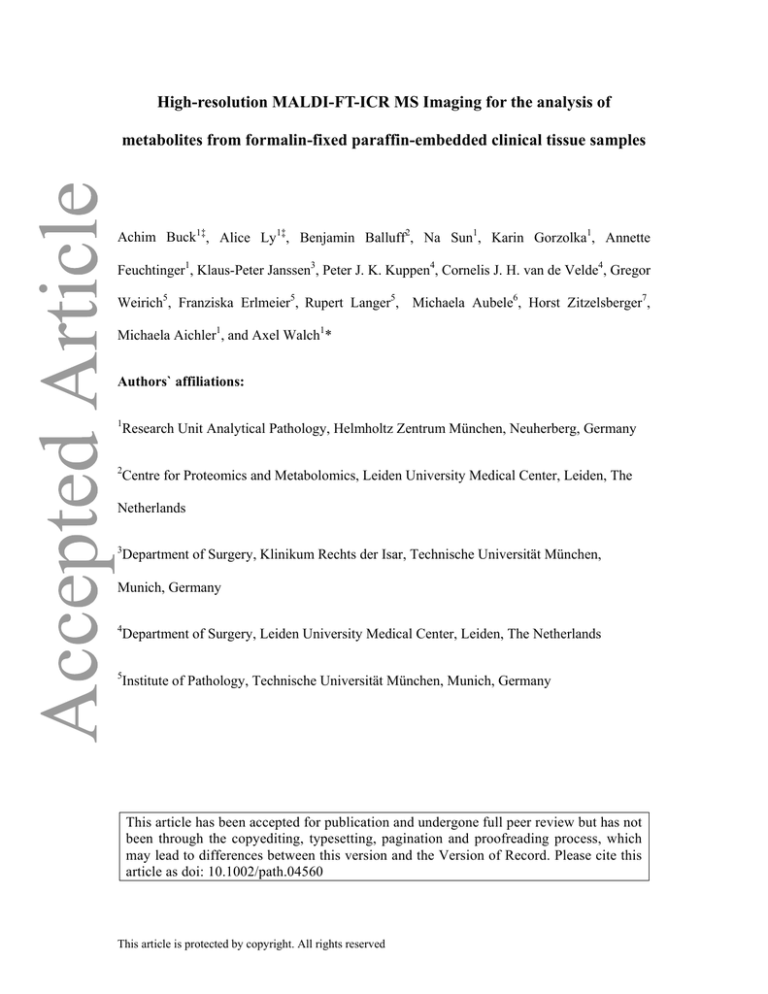
High-resolution MALDI-FT-ICR MS Imaging for the analysis of
metabolites from formalin-fixed paraffin-embedded clinical tissue samples
Achim Buck1‡, Alice Ly1‡, Benjamin Balluff2, Na Sun1, Karin Gorzolka1, Annette
Feuchtinger1, Klaus-Peter Janssen3, Peter J. K. Kuppen4, Cornelis J. H. van de Velde4, Gregor
Weirich5, Franziska Erlmeier5, Rupert Langer5, Michaela Aubele6, Horst Zitzelsberger7,
Michaela Aichler1, and Axel Walch1*
Authors` affiliations:
1
Research Unit Analytical Pathology, Helmholtz Zentrum München, Neuherberg, Germany
2
Centre for Proteomics and Metabolomics, Leiden University Medical Center, Leiden, The
Netherlands
3
Department of Surgery, Klinikum Rechts der Isar, Technische Universität München,
Munich, Germany
4
Department of Surgery, Leiden University Medical Center, Leiden, The Netherlands
5
Institute of Pathology, Technische Universität München, Munich, Germany
This article has been accepted for publication and undergone full peer review but has not
been through the copyediting, typesetting, pagination and proofreading process, which
may lead to differences between this version and the Version of Record. Please cite this
article as doi: 10.1002/path.04560
This article is protected by copyright. All rights reserved
6
Institute of Pathology, Helmholtz Zentrum München, Neuherberg, Germany
7
Research Unit Radiation Cytogenics, Helmholtz Zentrum München, Neuherberg, Germany
‡
These authors contributed equally to this work.
*Correspondence to: A Walch, Research Unit Analytical Pathology, Helmholtz Zentrum
München, Ingolstädter Landstr. 1, 85764 Neuherberg, Germany; E-mail:
axel.walch@helmholtz-muenchen.de; Phone: +49 89 3187 2739; Fax: +49 89 3187 3349
Conflict of interest:
The authors disclose no potential conflicts of interest.
Keywords: formalin-fixed paraffin-embedded tissue; MALDI; Imaging Mass Spectrometry;
metabolite; cancer
This article is protected by copyright. All rights reserved
ABSTRACT
We present the first analytical approach to demonstrate the in situ imaging of metabolites
from formalin-fixed paraffin-embedded (FFPE) human tissue samples. Using high-resolution
Matrix-Assisted Laser Desorption/Ionization Fourier-Transform Ion Cyclotron Resonance
Mass Spectrometry Imaging (MALDI-FT-ICR MSI), we conducted a proof of principle
experiment comparing metabolite measurements from FFPE and fresh frozen tissue sections,
and found an overlap of 72% amongst 1700 m/z species. In particular, we observed
conservation of biomedically relevant information at the metabolite level in FFPE tissues. In
biomedical applications, we analysed tissues from 350 different cancer patients, and were
able to discriminate between normal and tumour tissues, and different tumours from the same
organ, and found an independent prognostic factor for patient survival. This study
demonstrates the ability to measure metabolites in FFPE tissues using MALDI-FT-ICR MSI,
which can then be assigned to histology and clinical parameters. Our approach is a major
technical, histochemical and clinicopathological advance that highlights the potential for
investigating diseases in archived FFPE tissues.
INTRODUCTION
A broad spectrum of diseases are diagnosed based on histology - the microscopic anatomy of
samples resected from patients. The gold standards for histopathological analysis, valid
diagnosis and patient treatment are based on formalin-fixed paraffin-embedded (FFPE)
patient samples. Formalin fixation was first reported in 1893 and has been shown to maintain
tissue integrity for many years [1]. Formalin fixation preserves tissues by forming methylene
bridge cross-linkages between proteins, and the sample is then dehydrated with graded
ethanol, immersed in an organic solvent (e.g. xylene) to clear the alcohol, and then infiltrated
This article is protected by copyright. All rights reserved
with molten paraffin. Much effort has been spent in the last decades on standardizing FFPE
protocols. Compared to fresh frozen (FF) samples, FFPE tissues can be easily archived for
many years with corresponding patient data for retrospective reassessment and
clinicopathological studies. While histology is a reliable tool, advanced techniques have
expanded knowledge of the molecular and genetic content of tissues, which is not readily
apparent when assessing patient samples based on histology [2,3].
Matrix-Assisted Laser Desorption/Ionization Mass Spectrometry Imaging (MALDI-MSI) is a
powerful technique combining mass spectrometry with histology, allowing for the spatiallyresolved and label-free detection of hundreds to thousands of compounds within a single
tissue section. Depending on the sample preparation and instrumentation, MALDI-MSI can
detect a wide variety of molecular classes, e.g. proteins, peptides, lipids, drugs and others
[4,5]. Recently, the development of devices that have a high resolving power for small
molecular weight compounds, e.g. AP-SMALDI-Orbitrap or MALDI-FT-ICR MS, have
allowed for the in situ detection and visualization of metabolites and different metabolic
states within tissues [6,7]. FF samples are currently preferred over FFPE in tissue-based
MALDI-MSI studies. This is primarily due to concerns regarding the effect of chemical
processing on molecular content, molecular delocalization from washing steps and the belief
that paraffin would cause ion suppression [4,8]. At present, MALDI-MSI of FFPE tissue has
primarily concentrated on protein and peptide content, the protocol for which utilizes
deparaffination, antigen-retrieval and enzyme digestion adapted from immunohistochemical
procedures [4].
Measurements of small molecule metabolites (<1500 Da) are emerging in importance as
these levels reflect gene expression, protein function, environmental factors and metabolic
pathways [9]. In addition, perturbed metabolism is a hallmark of many diseases, e.g. cancer
This article is protected by copyright. All rights reserved
and degenerative conditions [10]. While metabolite measurements from homogenized FFPE
tissue using liquid based mass spectrometry have been conducted [11,12], liquid samples
cannot provide information on molecular spatial distribution. This is particularly important as
tissues are highly complex and heterogeneous systems. Given the ability to measure
metabolites from FFPE samples using liquid mass spectrometry, we hypothesized that it
should also be feasible in MSI.
We present the first study of in situ MALDI-FT-ICR MSI of metabolites from FFPE tissue
samples. Using a simple experimental workflow and different comparison paradigms, we
demonstrate the localization of different metabolites, which was used to answer tumour
biology and clinical questions.
MATERIALS AND METHODS
Collection of tissue samples
Primary surgical resection specimens were obtained from patients diagnosed with colon
adenocarcinoma (n = 102; all pT2 according to UICC classification [13]), breast cancer (n =
33), gastric adenocarcinoma (n = 102), renal oncocytoma (n = 21), chromophobe renal cell
carcinoma (n = 11), and oesophageal adenocarcinoma (n = 53). Samples were collected
between 1993 and 2010 at the Dept. of Surgery, Klinikum Rechts der Isar, Munich, Germany,
and at Leiden University Medical Center, Leiden, the Netherlands. This study was approved
by the local Ethics Committees; all patients provided informed, signed consent (Germany);
Code of conduct for responsible use of human tissue for research (the Netherlands). Followup data were available for patients and survival rates calculated from the date of surgical
resection to the date of last follow-up or death. All FFPE samples were collected in Munich.
This article is protected by copyright. All rights reserved
Table S1 is a summary of patient numbers and sample type (FF or FFPE).
FFPE samples were fixed for 12-24 hours in 10% Neutral Buffered Formalin then embedded
in paraffin using standardised and automated procedures. The samples were dehydrated in
graded ethanol, cleared with xylene, and embedded in molten paraffin [14]. Fresh-frozen
samples were stored post-surgery in liquid nitrogen until measurement. Frozen (12µm) and
FFPE sections (4µm) were mounted onto indium-tin-oxide (ITO) coated glass slides (Bruker
Daltonik, Bremen, Germany) pre-treated with 1:1 poly-L-lysine (Sigma Aldrich, Munich,
Germany), and 0.1% Nonidet P-40 (Sigma).
MALDI imaging mass spectrometry
Prior to matrix application, FF sections were dehydrated in a vacuum for 1h at room
temperature, FFPE sections were incubated for 1 hr at 70°C, de-paraffinized in xylene (2x 8
minutes), and allowed to air-dry. Matrix application and MALDI-MSI were conducted as
previously described.[7] Briefly, frozen and FFPE samples were coated in 10mg/ml 9aminoacridine matrix in 70% methanol using a SunCollect sprayer (Sunchrom,
Friedrichsdorf, Germany) [7]. MSI was performed in negative ion mode on a Bruker Solarix
7T FT-ICR MS (Bruker), over a mass range of m/z 50 - 1000, and 60µm lateral resolution.
All measurements included a non-tissue measurement region as a background control.
Following measurement, the matrix was removed with 70% ethanol, stained with HE,
coverslipped, scanned with a Mirax Desk scanner (Zeiss, Göttingen, Germany) with a 20x
magnification objective, and co-registered to respective MSI data using FlexImaging v. 4.0
(Bruker). Stained slides were examined by a pathologist and samples excluded if they
contained no tumour or if the section was lost during HE staining. Using FlexImaging,
acquired data were normalised against the root mean square of all data points, and histologyguided regions of interest (ROIs) were annotated (e.g. tumour or mucosa) and the spectral
This article is protected by copyright. All rights reserved
data exported [7]. On-tissue MS/MS was conducted on FFPE tissue samples using continuous
accumulation of selected ions mode and collision induced dissociation (CID) in collision cell
[7]. To test the reproducibility we measured consecutive serial sections of breast cancer tissue
microarrays (TMAs, n = 3; tissue cores = 40) on separate days.
Bioinformatics and Statistical Analysis
Subsequent data processing was performed with a MATLAB script using the bioinformatics
and image processing toolboxes (v.7.10.0, MathWorks, Natick, MA, USA). All exported
spectra underwent baseline subtraction to remove noise, resampling to lower data
dimensionality, and smoothing to remove tissue and measurement artifacts [15]. Peak picking
was conducted using a modified version of the LIMPIC algorithm [16], using m/z 0.0005
minimal peak width, signal to noise threshold of 2, and intensity threshold of 0.01%. Peaks
were picked if found in 80% of the samples in each group (e.g. tumour or mucosa). Isotopes
were automatically identified and excluded. To identify statistically significant differences in
m/z values, the peaklists were analysed with the Mann-Whitney U test and BenjaminiHochberg post hoc test (alpha = 0.05). If not otherwise stated, m/z values that were found also
to occur in the non-tissue measurement region (acting as a background control) were
excluded from these peak lists on the basis that m/z values that occurred in the non-tissue
region could also be molecules from the slide surface.
PCA and heatmaps were created with MetaboAnalyst 3.0 (http://www.metaboanalyst.ca)
[17]. Peak lists with respective intensities for ROIs were uploaded to MetaboAnalyst,
processed with a mass tolerance of m/z 0.0001, no data filtering, and log transformed. The
resultant PCA and heatmaps of metabolite data were exported as figures.
Significance Analysis of Microarrays (SAM) was used to identify disease-free survivalassociated m/z values (q - value < 0.05). The average peak intensity was used to split patients
This article is protected by copyright. All rights reserved
into good and poor survivor groups and significant differences in their survival were
determined with the log-rank test. Multivariate survival analysis was performed using Cox
proportional hazards regression models. All calculations were performed within R (‘samr’
and ‘survival’ packages). P-values <0.05 were considered significant.
Metabolite Identification
Metabolites were identified either by comparison to observed MS/MS spectra with standard
compounds or by matching accurate mass with Metlin (http://metlin.scripps.edu/index.php)
and the Human Metabolome Database (http://www.hmdb.ca) [18,19]. Search parameters
were 3 ppm mass tolerance and [M-H]- charge. In silico analysis using Bruker DataAnalysis
and SmartFormula was used to determine the molecular formula of m/z 256.9975. Raw
spectra from the Barrett’s TMA where m/z 256.9975 was highly intense were extracted and
examined in Bruker DataAnalysis. The spectra were recalibrated using 9-AA as a reference
peak ([M-H]- 193.07712), and then analysed using a FTMS peak finder. Using
SmartFormula, H/C ratio was set from 0 to 3; the number of rings and double bonds were
restricted to 0.5 to 40; and the option to automatically detect isotopic mass was activated.
Molecular formulas were predicted allowing structures containing sulphate and phosphate;
and M-H, M+H2O-H, M+Na-H2, M+K-H2 as negative adducts. Mass error tolerance was set
at < 1 ppm; mass charge as -1. mSigma values – the match factors between the measured
isotopic pattern and theoretical pattern of a given formula – less than 50 were considered a
good match. A database search using Compound Crawler, including ChEBI, Chemspider,
KEGG, and Metlin, was performed to produce compound structures.
This article is protected by copyright. All rights reserved
RESULTS
In a first proof of principle study, we examined whether it was possible to conduct metabolite
measurements from FFPE samples and if the detected compounds were comparable to those
found in FF tissues. As stated, MALDI-MSI for FFPE protein and peptide content require
many preparation steps [1]. In contrast, our workflow for FFPE metabolite imaging consisted
only of deparaffination and matrix application (Figure 1).
Comparison of FF and FFPE tissue samples revealed a high overlap of metabolite
content
Measurements from 21 FF and 81 FFPE colon cancer samples were compared. Automated
peak picking found 1470 peaks in FFPE and 1465 peaks in FF colon cancer samples (Figure
2A), indicating that the number of detected peaks is not overly affected by sample
preparation. 1226 peaks overlapped between the FFPE and FF datasets indicating that
detected metabolite content of the samples is similar. FF and FFPE samples were measured
over a mass range of m/z 50 - 1000. Examples of average overall spectra are presented in
Figure 2B. Peaks in the m/z 50 - 400 range are more intense in the FFPE sample while peaks
in the m/z 600 - 1000 range are more prominent in the FF sample. The mass range between
m/z 50 – 400 is composed of non-lipid low molecular weight metabolites, while m/z 400 1000 consists mostly of lipids [20].
Reproducibility assessment
To examine reproducibility of our FFPE metabolite imaging approach, serial sections of
breast cancer tissue microarrays (TMAs, n = 3; tissue cores = 40) were measured on separate
days. TMAs are paraffin blocks containing samples from many different patients; an
advantage of which is the simultaneous measurement of many samples in a single
This article is protected by copyright. All rights reserved
experiment. Overall peaks of m/z values from each replicate, scatterplots of the intensities
from individual cores and visualizations are presented in Figure S1A. Hierarchical clustering
of the measurements was used to group five individual patients into separate clustering
groups showing that our approach is reproducible (Figure S1B).
Spatial and chemical conservation of metabolites in tissue sections
Localizations for different m/z values in FF and FFPE tissues from colon cancer patients are
presented in Figure 3. m/z 259.0140 (galactose-1-phosphate) localized to mucus. In contrast,
hexose-6-phosphate (H6P; m/z 259.0230) is present across both samples but most intensely in
tumour regions. Carnitine (m/z 160.8420) and N-Acetylglucosamine sulfate (m/z 300.0400)
are localized to blood and tumour stroma, respectively. Figure S2 demonstrates the high
spatial coherence between the histological features and m/z localization. Higher
magnification images of single patient cores from the FFPE TMA show that the m/z
distributions are spatially conserved even in small tissue sections (for further information see
also Figure S3). This is a particular breakthrough as it has been thought that FFPE tissue
processing would cause delocalization of molecules leading to inaccurate distributions [8].
Sample ion maps of other m/z values that occur in both FF and FFPE tissue are presented in
Figure S4. It can be seen that most metabolites occur with similar intensities and localizations
in both FF and FFPE. Interestingly, despite the embedding process, we could annotate some
m/z values to lipids in the m/z 600 - 1000 range. Representative ion images of lipids are
shown in Figure S4, for example m/z 599.3216 (phosphatidylinositol, PI(18:0/0:0)) and m/z
701.5150 (phosphatidic acid, PA(18:0/18:1)).
Identification and validation of metabolites
On-tissue MS/MS was conducted on FFPE sections to confirm that the detected peaks
corresponded to metabolites. Focusing on nucleotides and metabolites from the central
This article is protected by copyright. All rights reserved
carbon metabolism pathway, AMP, GMP, and GDP were confirmed by comparison of ontissue MS/MS spectra to standard compounds (Figure S5). Hexose-6-phosphate, glycerol
monophosphate and UDP were confirmed by accurate mass matching to databases.
Distinction between tumour and normal tissue specimens
To test whether metabolite profiles could distinguish between normal and diseased tissue, a
TMA (n = 28 patient tissue samples) with matched normal and colon cancer tissue was
measured and stained afterwards with haematoxylin and eosin (HE). Regions of interest
(ROIs) for normal mucosa and tumour were annotated using histology as a guide. For the
layout of the TMA, please refer to Figure S6A. Principal component analysis (PCA)
scatterplots of the individual ROIs showed that tumour and mucosa sample clusters are
distinct from each other (Figure S7). Mass spectra from these ROIs were then compared and
statistical analysis found 182 significantly different m/z values (p <0.05). A heatmap of the
top 25 significant m/z values demonstrates clear differences in the intensity patterns between
tumour and normal mucosa (Figure 4A). Figure 4B shows peak intensity differences and
visualizations for two of these m/z values (m/z 256.9975 and m/z 599.3200). These m/z values
were also found to correspond to mucosa and tumour in FF tissue (Figure S4). A higher
magnification of a normal mucosa sample indicates that m/z 256.9975 directly localizes to
epithelium within the tissue. In another example, a gastric cancer TMA and a whole resected
cancer sample, m/z 282.0292 coincided with desmoplastic stroma and m/z 444.0808 revealed
molecular heterogeneity within the tumour (Figure S8).
Distinction between chromophobe renal cell carcinoma and renal oncocytoma
Chromophobe renal cell carcinoma (ChRCC) and renal oncocytoma have different clinical
outcomes. The separation of these tumour types using light microscopy of conventional HE
staining remains difficult in some cases. Therefore our metabolite imaging approach was
This article is protected by copyright. All rights reserved
applied to discriminate between these tumour types that arise from renal tissue.
MALDI-FT-ICR MSI was conducted on TMAs consisting of 11 ChRCC and 21 oncocytoma
cases. For the layout of the ChRCC and oncocytoma TMAs, please refer to Figure S6B and
S6C, respectively. 123 peaks displayed significantly different intensities between the tumour
types (p <0.05). As an example, phosphoethanolamine (m/z 862.6105) was detected with
increased intensity in ChRCC samples compared to oncocytoma (Figure 5A). In contrast, 2amino AMP (m/z 345.0720) was elevated in oncocytoma compared to ChRCC (Figure 5A).
PCA (Figure 5B) was able to distinguish between ChRCC and oncocytoma samples, and a
heatmap (Figure 5C) of the 50 most significant m/z values demonstrates that hierarchical
clustering can differentiate between oncocytoma and ChRCC based on m/z expression
patterns. Metabolite imaging can therefore differentiate between tumours of the same origin.
Survival analysis reveals an independent prognostic marker in oesophageal
adenocarcinomas
We next investigated whether metabolite imaging could be used to address patient survival
outcome. Tumour-specific spectral data was obtained from a TMA containing 53
oesophageal adenocarcinomas and survival analysis was conducted (Figure S9). The mean
age at the time of surgery was 61 years, and the maximum follow up time was 162 months.
Median disease-free survival time was 15 months, and median overall survival time was 18
months. The clinicopathological parameters of the tumour set are summarized in Table S2.
Uni- and multivariate statistical analysis (with correction of cumulative alpha-errors) found
m/z 256.9975 correlated significantly with disease-free survival, and constitutes an
independent prognostic parameter in multivariate analysis, in comparison to the clinical
standard for tumour staging, the TNM system according to UICC classification (Figure 6)
[13]. As no database annotation was available for m/z 256.9975, in silico molecular formula
This article is protected by copyright. All rights reserved
analysis utilising isotope fine structure was used to provide an identity. Analysis of the
isotopic pattern predicts that m/z 256.9975 has a molecular formula C6H10O9S (mSigma
28.6). An integrated structure search found eight different compounds with the molecular
formula C6H10O9S (Figure S10), which were deoxy sugar acids with sulphate esters.
DISCUSSION
This is the first study describing metabolite measurements with MALDI-FT-ICR MSI using
FFPE tissues, thereby demonstrating a high-degree of chemical metabolite conservation in
FFPE tissue samples. The comparison between FF and FFPE datasets indicate similar
metabolite spatial localization in tissue sections. For example, hexose-phosphate was more
concentrated in tumour than in normal tissue in both FF and FFPE samples (Figure 3),
confirming the energy competition also known as Warburg effect – the increased rate of
glycolysis in tumours [10]. In FFPE samples, peaks of metabolites were detected in low mass
range (m/z 50 - 400) having similar intensity compared to FF. In contrast, peak intensities
were significantly reduced above the mass range of m/z 600. This result corresponds with the
expectation that tissue embedding process and the removal of paraffin wax by solvents (e.g.
xylene) remove lipids, too. Despite this, we found a conservation of solvent-resistant lipids
which remain present in formalin-fixed tissue (Figure S4). It is known that cellular
components such as nucleic acids, carbohydrates, and lipids are not fixed directly by
formaldehyde, but can be trapped in the network of cross-links between proteins [21]. In a
previous study, it was suggested that methylene chains of free, unbound tissue lipids are
removed from the tissue, while solvent-resistant lipids remain present in formalin-fixed tissue
due to being locked into protein–lipid complex matrices, predominantly in the membranes
[22].
This article is protected by copyright. All rights reserved
Currently, the outcome of metabolic research based on FFPE tissue is very restricted although
analysis of FFPE samples in a clinical and biological context is desirable. Commonly used
techniques in metabolomics are nuclear magnetic resonance spectroscopy and liquid based
MS (e.g. liquid chromatography MS and gas chromatography MS). Efforts were made to
establish extraction and purification protocols for metabolite detection by liquid based MS
[11,12]. But these protocols face challenges as liquid based MS techniques require large
tissue amounts in order to achieve satisfactory metabolite yields for analyses. Additionally,
tissue homogenizing leads to loss of specificity reducing significant results. An advantage of
MSI is that spatial and chemical integrity are maintained and therefore enables detailed
readouts from images by performing virtual micro-dissection (defined as region of interest) of
spatially-resolved mass spectra. In a proof of principle this information was used to
successful discriminate the metabolite content of normal and diseased tissue (Figure 4).
Moreover, we determined the metabolic 'fingerprints' of chromophobe renal cell carcinoma
(ChRCC) and renal oncocytoma using TMAs (Figure 5). The distinction between ChRCC
and oncocytoma is challenging in some cases because both tumours share morphological and
immunophenotypic features. ChRCC and renal oncocytoma are thought to arise from the
distal tubuli of the kidney but have differing prognostic and clinical outcomes that influence
treatment, making accurate diagnosis of utmost importance [23]. The separation of ChRCC
and renal oncocytoma by metabolite signatures, as well as the possible high-throughput of
large patient cohorts and the easy sample handling demonstrate advantages of MALDI FTICR MSI as a potential diagnostic tool. Furthermore, our approach was used to analyse
clinical endpoints such as patient prognosis. Linking molecular data from 53 oesophageal
adenocarcinomas by MSI to clinical data revealed an independent prognostic factor for
overall survival (Figure 6). In silico analysis of the prognostic m/z value indicates that this
molecule is most likely a deoxy sugar acid with ester sulphate. Previous studies have shown
This article is protected by copyright. All rights reserved
that duodenal and gastric mucus contains acid polysaccharides with ester sulphate [24,25]. It
has been reported that sulphated polysaccharides are associated with Barrett’s oesophagus
and Barrett’s carcinoma [26]. Given the functions of sulphated polysaccharide structures as
ligands, alterations in the sulphation of metaplastic cells, as present in Barrett’s oesophagus,
could have important effects on differentiation and malignant progression [27].
MALDI-MSI of FFPE tissue has so far concentrated only on protein and peptide analyses.
Protocols for peptide measurements from TMAs are more complex and incorporate an
antigen retrieval step, deparaffinization, in situ trypsin digestion and matrix application which
can challenge the reproducibility. In this study we acquired reliable and reproducible data
from TMAs and detected much more m/z species compared to the achieved number of
molecules obtained in peptide measurements on FFPE tissues [28].
The ability to image metabolites is the starting point to investigating metabolic pathways in
FFPE tissues, and should enable distinguishing the exact location of metabolic disturbances.
In addition, the continual improvement in the mass resolution of MSI instrumentation may
increase the likelihood of detecting low abundance metabolites that may be masked by the
peaks of more abundant molecules. This would in turn lead to improved annotation of
detected peaks. Prospectively, it is likely possible to measure hundreds of molecules and
generate pathways from thousands of patients when using TMAs. Given that FFPE samples
have been archived for decades in hospitals and universities around the world, this presents
an unparalleled source of information on diseases. In summary, our study is therefore not
only a major technical advance but may have direct impact on predicting patient outcome and
diagnosis, and tissue-based research in general.
This article is protected by copyright. All rights reserved
Acknowledgements
This project was funded by the Ministry of Education and Research of the Federal Republic
of Germany (BMBF) (Grant No. 01ZX1310B) and the Deutsche Forschungsgemeinschaft
(Grant Nos/ HO 1254/3-1, SFB 824 TP Z02 and WA 1656/3-1) to AW. Ulrike Buchholz,
Claudia-Mareike Pflüger, Gabriele Mettenleiter, and Andreas Voss provided technical
assistance. Daniela Borgmann provided bioinformatics assistance.
Author contributions:
AB and AL were responsible for the MALDI imaging mass spectrometry data acquisition,
data analyses and wrote the manuscript. BB was involved in data analyses and provided
bioinformatics assistance. NS and KG carried out validation experiments. MAi, AF and KPJ
assisted in interpretation of the results. MAi, BB and HZ assisted in interpretation of the
results and writing of the manuscript. KPJ, PJKK, CJHvdV, GW, FE, RL and MAu provided
samples and assisted in histological interpretation of the samples. AW performed
histopathological interpretation, conceived the study design, as well as wrote the manuscript.
All authors approved the final version of this manuscript.
This article is protected by copyright. All rights reserved
REFERENCES
1.
2.
3.
4.
5.
6.
7.
8.
9.
10.
11.
12.
13.
14.
15.
16.
17.
18.
19.
20.
Casadonte R, Caprioli RM. Proteomic analysis of formalin-fixed paraffin-embedded
tissue by MALDI imaging mass spectrometry. Nature protocols 2011; 6: 1695-1709.
Cancer Genome Atlas Research N. Comprehensive molecular characterization of
gastric adenocarcinoma. Nature 2014; 513: 202-209.
Wagle N, Berger MF, Davis MJ, et al. High-throughput detection of actionable
genomic alterations in clinical tumor samples by targeted, massively parallel
sequencing. Cancer discovery 2012; 2: 82-93.
Norris JL, Caprioli RM. Analysis of tissue specimens by matrix-assisted laser
desorption/ionization imaging mass spectrometry in biological and clinical research.
Chemical reviews 2013; 113: 2309-2342.
Rompp A, Spengler B. Mass spectrometry imaging with high resolution in mass and
space. Histochemistry and cell biology 2013; 139: 759-783.
Rompp A, Guenther S, Schober Y, et al. Histology by mass spectrometry: label-free
tissue characterization obtained from high-accuracy bioanalytical imaging.
Angewandte Chemie 2010; 49: 3834-3838.
Sun N, Ly A, Meding S, et al. High-resolution metabolite imaging of light and dark
treated retina using MALDI-FTICR mass spectrometry. Proteomics 2014; 14: 913923.
Nilsson A, Goodwin RJ, Shariatgorji M, et al. Mass Spectrometry Imaging in Drug
Development. Analytical chemistry 2015.
Wishart DS. Proteomics and the human metabolome project. Expert review of
proteomics 2007; 4: 333-335.
Warburg O. On the origin of cancer cells. Science 1956; 123: 309-314.
Kelly AD, Breitkopf SB, Yuan M, et al. Metabolomic profiling from formalin-fixed,
paraffin-embedded tumor tissue using targeted LC/MS/MS: application in sarcoma.
PloS one 2011; 6: e25357.
Yuan M, Breitkopf SB, Yang X, et al. A positive/negative ion-switching, targeted
mass spectrometry-based metabolomics platform for bodily fluids, cells, and fresh and
fixed tissue. Nature protocols 2012; 7: 872-881.
UICC. TMN Classification of Malignant Tumours. (Seventh ed). Wiley-Blackwell,
2009.
Ergin B, Meding S, Langer R, et al. Proteomic analysis of PAXgene-fixed tissues.
Journal of proteome research 2010; 9: 5188-5196.
McDonnell LA, van Remoortere A, de Velde N, et al. Imaging mass spectrometry
data reduction: automated feature identification and extraction. Journal of the
American Society for Mass Spectrometry 2010; 21: 1969-1978.
Mantini D, Petrucci F, Pieragostino D, et al. LIMPIC: a computational method for the
separation of protein MALDI-TOF-MS signals from noise. BMC bioinformatics 2007;
8: 101.
Xia J, Psychogios N, Young N, et al. MetaboAnalyst: a web server for metabolomic
data analysis and interpretation. Nucleic acids research 2009; 37: W652-660.
Smith CA, O'Maille G, Want EJ, et al. METLIN: a metabolite mass spectral database.
Therapeutic drug monitoring 2005; 27: 747-751.
Wishart DS, Jewison T, Guo AC, et al. HMDB 3.0--The Human Metabolome
Database in 2013. Nucleic acids research 2013; 41: D801-807.
Wang J, Qiu S, Chen S, et al. MALDI-TOF MS Imaging of Metabolites with a N-(1Naphthyl) Ethylenediamine Dihydrochloride Matrix and Its Application to Colorectal
Cancer Liver Metastasis. Analytical chemistry 2015; 87: 422-430.
This article is protected by copyright. All rights reserved
21.
22.
23.
24.
25.
26.
27.
28.
Renshaw S. Immunochemical staining techniques. ed). Scion Publishing Ltd:
Bloxham, UK, 2007; ch. 4.
Hughes C, Gaunt L, Brown M, et al. Assessment of paraffin removal from prostate
FFPE sections using transmission mode FTIR-FPA imaging. Anal Methods 2014; 6:
1028-1035.
Carvalho JC, Wasco MJ, Kunju LP, et al. Cluster analysis of immunohistochemical
profiles delineates CK7, vimentin, S100A1 and C-kit (CD117) as an optimal panel in
the differential diagnosis of renal oncocytoma from its mimics. Histopathology 2011;
58: 169-179.
Andre F, Bouhours D, Andre C, et al. The carbohydrate and ester sulfate content of
mucosal biopsies in health and in patients with duodenal ulcer. Clinica chimica acta;
international journal of clinical chemistry 1974; 56: 255-259.
Schrager J. Sulphated Mucopolysaccharides of the Gastric Secretion. Nature 1964;
201: 702-704.
Endo T, Tamaki K, Arimura Y, et al. Expression of sulfated carbohydrate chain and
core peptides of mucin detected by monoclonal antibodies in Barrett's esophagus and
esophageal adenocarcinoma. Journal of gastroenterology 1998; 33: 811-815.
Bodger K, Campbell F, Rhodes JM. Detection of sulfated glycoproteins in intestinal
metaplasia: a comparison of traditional mucin staining with immunohistochemistry
for the sulfo-Lewis(a) carbohydrate epitope. Journal of clinical pathology 2003; 56:
703-708.
De Sio G, Smith AJ, Galli M, et al. A MALDI-Mass Spectrometry Imaging method
applicable to different formalin-fixed paraffin-embedded human tissues. Molecular
bioSystems 2015.
This article is protected by copyright. All rights reserved
Figure 1. Scheme of the method and study design, and application of the analytical approach
to important biomedical questions. (FF, fresh frozen; FFPE, formalin-fixed paraffinembedded).
This article is protected by copyright. All rights reserved
Figure 2. (A) Venn diagram showing the number of peaks found in FF tissue and FFPE
samples. A total of 1465 peaks were detected in FF tissue and 1470 from FFPE, with an
overlap of 1226 peaks found in both datasets (grey). (B) Examples of spectra from FFPE
(green) and FF (red) samples. Inset: peaks from low (i), middle (ii) and higher (iii) mass
ranges.
This article is protected by copyright. All rights reserved
Figure 3. Comparison of m/z localisation in colon cancer samples from whole resected FF,
FFPE, and FFPE TMA. Top panels are HE-stained FF, FFPE, and TMA colon cancer tissue
sections showing regions corresponding to tumour (black dotted line), and mucosa (black
solid line). m/z 259.0140 (galactose-1-phosphate; green) localises to mucus. m/z 259.0224
(H6P; red) is most intense in the tumour regions in FF and FFPE samples. m/z 300.0400 (NAcetylglucosamine sulphate; yellow) corresponds to tumour stroma – tissue which supports
tumour growth. m/z 160.8420 (Carnitine; blue) is found in the vicinity of blood. Higher
magnification images of single patients samples from the TMA (right) show the m/z
distributions are specific even in small tissue sections. White dotted lines indicate the
magnified cores.
This article is protected by copyright. All rights reserved
Figure 4. Discrimination of tumour tissue from normal colonic mucosa in FFPE TMA. (A)
Heatmap of top 25 significant m/z values demonstrate different m/z expression patterns in
mucosa vs. tumour. (B) Average spectra of m/z 256.9975 and m/z 599.3200 and localisation
overlaid on corresponding HE-stained samples. m/z 256.9975 was more intense in mucosa
(green) than tumour (red); a close up shows it to be specific for mucus-producing epithelium.
m/z 599.3200 is more intense in tumour regions.
This article is protected by copyright. All rights reserved
Figure 5. Metabolite MALDI-FT-ICR-MSI of renal oncocytoma vs. ChRCC. (A) Spectra
and ion maps for m/z 862.6105 (phosphoethanolamine) and 345.0720 (2-amino AMP) show
differences in distribution and intensities in oncocytoma and ChRCC. (B) PCA accurately
distinguishes ChRCC (red) from oncocytoma (green). (C) Heatmap of top 50 differentially
intense m/z values.
This article is protected by copyright. All rights reserved
Figure 6. Metabolite imaging for addressing patient survival outcome. (A) Tumour-specific
metabolomic data from a TMA containing 53 oesophageal adenocarcinomas was submitted
to uni- and multivariate statistical analysis. m/z 256.9975 was found a significant prognostic
factor for disease-free survival of the patients (P=0.00154), independently of other survival
determinants given by the clinical TNM classification (A, inset; P=0.034). (B) Ion
distribution maps showing localisation of deoxy sugar acid with ester sulphate (m/z
256.9975) in regions of mucus (visualization in blue).
This article is protected by copyright. All rights reserved


